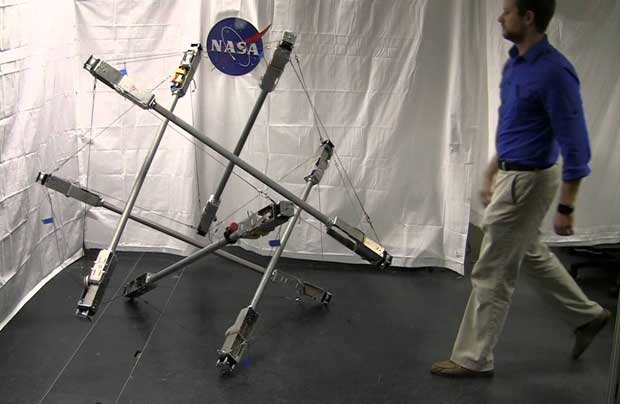NASA’s Super Ball Bot Could Be the Best Design for Planetary Exploration
IEEE Spectrum Feature
Excerpt from IEEE Spectrum article: NASA’s Super Ball Bot has to be one of the most bizarrely and effectively innovative robot designs we’ve ever come across. It’s a tensegrity structure, nothing more (and nothing less) than a bunch of rods connected by a bunch of cables. It’s almost certainly not what you picture when you think of a robot, much less a robot that’s intended to head into space. At NASA Ames Research Center, they’ve been working on this project through NASA’s Innovative Advanced Concepts (NIAC) program, and we have an update for you about what they’ve been up to. Here’s a great video where NASA researchers Vytas SunSpiral and Adrian Agogino describe the robot’s potential capabilities (photo of Andrew [Drew] Sabelhaus).
 A lightness of being: Space vehicles that can operate in the ultra low-gravity on asteroids and comets are having to employ novel locomotive systems
A lightness of being: Space vehicles that can operate in the ultra low-gravity on asteroids and comets are having to employ novel locomotive systems
Excerpt from the Economist, March 7, 2015: Rolling is another option for a rover operating in low gravity. One type, known as “structurally compliant” rovers, are designed specifically to roll along. These are constructed from a latticework of rigid rods connected with elastic cables. Mechanical actuators are used to shorten and lengthen the cables, so that the rovers change shape as they repeatedly tip over in the direction they want to go. Although more jerky than graceful, little traction is needed resulting in a “punctuated rolling motion”, says Alice Agogino, a NASA-funded researcher working on such a project at the University of California, Berkeley. The rovers’ instruments and power supply would be suspended in the centre of the structure.
Popular Science
A recent Popular Science article discusses the BEST Lab’s tensegrity robot project with NASA Ames’ Intelligent Systems Division. The NASA Innovative Advanced Technology (NIAC) tensegrity robot project named “Super Ball Bot,” which is being developed in collaboration between the Intelligent Robotics Group and Robust Software Engineering. This article, titled, “This Weird Tumbleweed Robot Might Change Planetary Exploration – A Rolling Sphere of Rods and Cables Being Developed by NASA Takes a Lickin’ and Keeps on Tickin’,” discusses the origins of this concept and how tensegrity robots could be the future of planetary exploration.
Discovery Channel
Also, check out this video on the Discovery Channel featuring the project, with ME undergraduate students Aliakbar Toghyan, Borna Dehghani, Laqshya Taneja, and Ian Matthew Krase, graduate students Andrew Sabelhaus and Kyunam Kim, and recent ME graduate Deaho Moon. BACKGROUND: Vytas SunSpiral and Adrian Agogino are Principal Investigators for a study from the NASA Innovative Advanced Concepts (NIAC) project “Super Ball Bot – Structures for Planetary Landing and Exploration.” The research covers robots made from “tensegrities” – structures that are composed of purely tensile (cables) and compressive (rods) components. Such robots could prove to be lightweight, strong, collapsable, energy efficient, and robust against high impacts and becoming immobile on rugged terrain. However, tensegrity control is difficult and poses formidable challenges. Solutions use a synergy of control technologies from both the Intelligent Robotics Group and the Robust Software Engineering Group to overcome these obstacles.
Wired Magazine: NASA’s latest robot: A Rolling tangle of rods that can take a beating
Wired Magazine, Feb. 2014 Excerpt:
It’s fun to think about how this concept could be applied outside the realm of space exploration. Drawing on natural systems that adjust and adapt to environments is fascinating, and one that’s already being explored in fields like architecture and art. While teaching a class at UC Berkeley, collaborator Alice Agogino asked students to come up with 50 potential applications for tensegrity robots and to rank them according to how useful they might one day be.
“The two highest fits were in home health care and the military,” he says. “Two extreme applications.” The point being, by its very nature a tensegrity robot is able to be both sturdy and resilient while still being gentle enough to interact with sick people. “This is really at the heart of what we’re getting at,” says SunSpiral. “Using a system that’s much more adaptable to its environment.”
